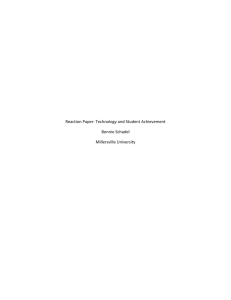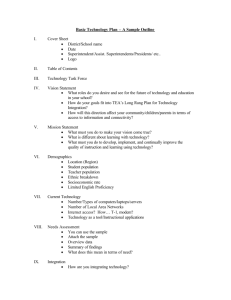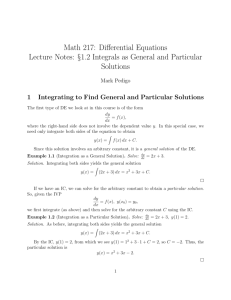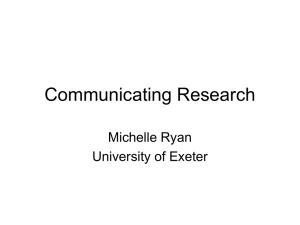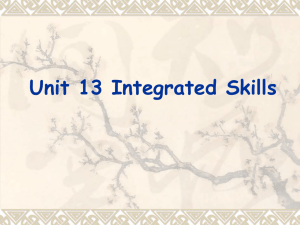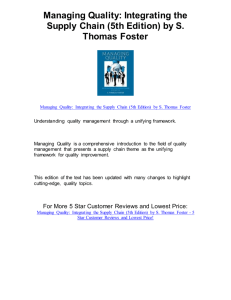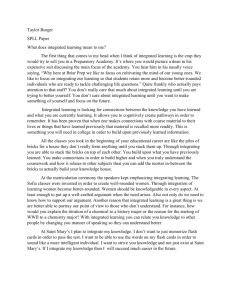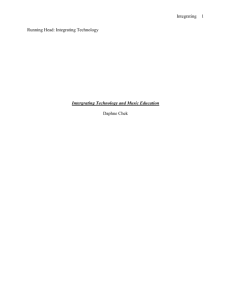Strengthening Christian, Moro & Lumad Relations
advertisement
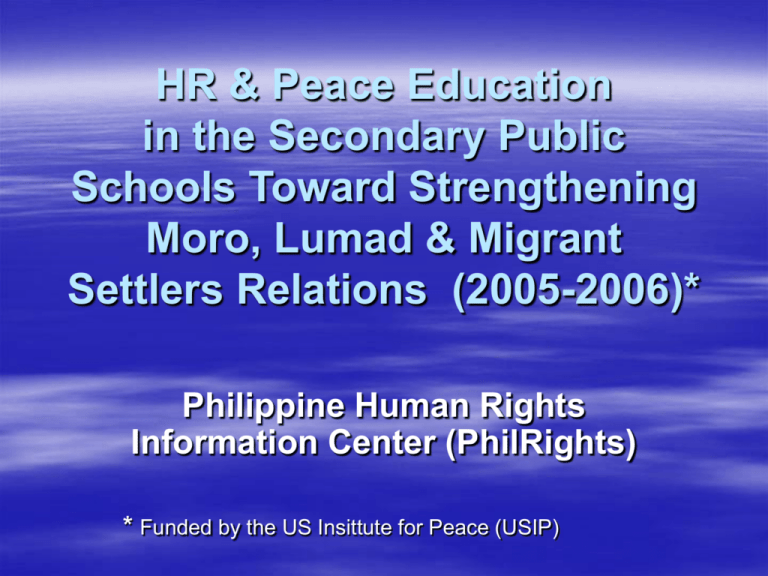
HR & Peace Education in the Secondary Public Schools Toward Strengthening Moro, Lumad & Migrant Settlers Relations (2005-2006)* Philippine Human Rights Information Center (PhilRights) * Funded by the US Insittute for Peace (USIP) Project Objectives Develop a teacher training module designed to infuse HR & peace education in formal education curriculum of public secondary schools Enhance capability of public secondary school teachers to implement the designed modules Project Sites & Reach Areas NCR (Pretest) Maguindanao No. of No. of Public Trainees HS (Teachers, admin, principals) Estimated # of students reached (1 teacher x 4 classes x 50 students/class) 5 12 2,400 14 47 9,400 North Cotabato 23 35 7,000 Total 42 94 18,800 Project Activitives 1. Networking with Project Partners & DepEd Institute for Peace & Development Studies, Southern Christian College (IPDS-SCC), Midsayap, North Cotabato Department of Education Region 12 Department of Education, Autonomous Region in Muslim Mindanao (ARMM) 2. Module Development Project Activitives 3. Three 5-day Trainings on “HR & Peace Integration” NCR – Pre-testing of First draft of Training Modules Maguindanao North Cotabato Contents of 5-day Teacher Training Topics taken up: HR concepts and principles HR instruments Theories on conflict and peace Historical roots of Mindanao conflict Theories and methods on HR & Peace integration Contents of 5-day Teacher Training Training methods include workshops, roleplaying, problem-tree construction, dance & song group dynamics, poem composition, local & indigenous ice-breakers/games Practicum involving actual lesson plan constructions and teaching demonstration in selected classes on various subjects using the prepared lesson plans. Project Activitives 4. Eight (8) Focused Group Discussions among Teachers/School Administrators/Principals & Students on the Training Modules Examples of experiences in how HR & peace were integrated in the subjects Effects on KAS of students, teachers, in and out of school Identification of enabling and disabling factors in the integration of HR & peace Project Activitives 5. Collection of Progress Reports of Techer Trainees 6. Educators’ Conference: “Kapayapaan at Karapatan sa Aming Paaralan: Paghahabi ng Karanasan” (HR & Peace in Our Schools: Weaving Our Experiences”) Provide a venue for sharing & exchange of experiences in integrating HR & Peace in various subject areas Project Activitives Come up w/ assessment of the effects/impact of the Training Gather feedback on the Training of Trainers Guidebook/Manual, and Generate ideas on how to move forward Summary of Achievements 1. 1,000 copies of the Training of Trainers Guidebook “On Integrating Peace & HR in Secondary Education: Towards Strengthening Lumad, Moro & Settler Relations in Mindanao” published & distributed to teacher participants, participating schools, partners, DepEd 2. Enhanced capability of 94 teachers/school administrators on HR & peace integration Summary of Achievements Increased knowledge & understanding on HR and situations of tri-people in Mindanao Increased skills on conflict mediation, teaching & integrating HR & peace in their subjects Developed positive attitudes toward students, colleagues, other ethnic groups 4. Developed strong interest among participants/educators to seriously undertake HR & Peace Integration in school curricula Summary of Achievements 5. Established partnership with DepEd 6. Established & maintained good relations w/ participating schools Summary of Evaluation Feedback I. Highlights & Key Lessons Integrating HR & Peace in teaching subjects facilitates learning – making subjects more relevant to day-to-day lives of students. Effective practice of HR & Peace Integration necessitates mastery of subjects & in-depth understanding of concepts of peace & HR Summary of Evaluation Feedback Use of vernacular or local dialect/s in discussion enables more students to participate Effectiveness of integration depends on the strategy/ies employed by teachers Integrating HR & Peace requires paradigm shift/renewal in terms of how teachers view their subjects, students, teaching strategies & themselves as persons Summary of Evaluation Feedback II. Best Practices Focused on Content HR & Peace are inherently connected to social sciences; integrating these concepts in Araling Panlipunan (Social Studies) is easy Integrating HR & Peace in other subject areas may not always be explicit or obvious but still possible Integrating HR & Peace in subjects other than Social Sciences can be facilitated by using topics as metaphors/symbolisms/parallelisms for topics related to HR & Peace Summary of Evaluation Feedback Thinking-outside-the-box or expanding imagination & creativity facilitates identification of connections between & among the subjects taught & HR & Peace There is need to access various available resource materials on HR & Peace & even subjects taught There is need to develop new resources that can aid in integration of HR & Peace into the various subject areas Summary of Evaluation Feedback There are different views re: Curricular reforms → Current curriculum needs to be further tested in terms of its effectiveness in relation to integrating HR & Peace into the various subject areas → HR & Peace canb e given emphasis by teaching them as units/topics in the subject of Araling Panlipunan or Social Studies. → HR & Peace can be treated as separate subject Summary of Evaluation Feedback III. Pedagogical Discoveries /Insights on Strategies There is no singular formula in integrating HR & Peace in teaching various subject areas Many strategies can be used in integration Choice of strategy/ies can be influenced by context of the teacher, students, learning environment & their surrounding environment Summary of Evaluation Feedback IV. Methodological Entry Points of HR & Peace Integration As an ethical principle of teaching & learning , i.e. teaching & learning w/ peace & respect for HR (student rights) As a relational framework to link lesson into everyday life As a point for analysis, reflection & application of the topic under study Summary of Evaluation Feedback As a selection guide in choosing appropriate strategy As an example to illustrate points being discussed As a context to constantly ground theoretical learning to practical learning. Summary of Evaluation Feedback V. Recommendations Urge schools to articulate in their VMG their commitment to uphold peace & HR Refer to DepEd Memo urging schools to integrate peace & HR in teaching Look into School Improvement Plan (SIP) as a venue to advocate promotion of HR & Peace Advocate among different stakeholders ( teachers, school heads, parents, students, community leaders, etc.) the integration of HR & Peace Summary of Evaluation Feedback On Continuing Teacher Education Undertake refresher courses on Human Rights & Peace Conduct training of teachers on HR & Peace integration Undergo gender sensitivity trainings (GST) Explore integrating HR & Peace as a component of Makabayan, particularly Values Education Summary of Evaluation Feedback Creation of Distance Learning Courses, i.e. through the Internet, on HR & Peace Integration Allot one session per week on HR & Peace in all Social Studies subjects Maximize opportunities to enhance & develop the self, i.e. participate in leadership seminars, advanced management training, religious seminars, etc. Summary of Evaluation Feedback On College Education Course Include units on HR & Peace in the undergraduate education curriculum Integrate HR & Peace in the Civil Service VOW Re-orient NSTP for aspiring teachers towards HR & Peace education Strengthen HR & Peace component of social sciences, especially in tertiary levels Thank you! Philippine Human Rights Information Center (PhilRights) 53-B Maliksi Street, Brgy. Pinyahan, Quezon City, Philippines 1800 Email Addres: prights@tri-isys.com Tel. Nos. +632 4331714 / 4365686
